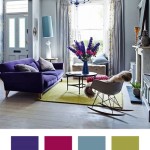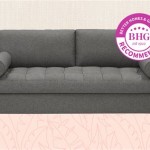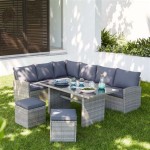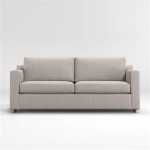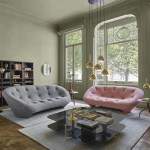Sofa Cushion Seats: A Comprehensive Guide
Sofa cushion seats are a critical component of furniture design, significantly impacting comfort, aesthetics, and overall longevity. The selection of appropriate materials and construction techniques for these cushions directly influences the seated experience and the lifespan of the sofa itself. Understanding the various factors involved in sofa cushion seat construction and maintenance is paramount for both consumers and furniture manufacturers.
The anatomy of a sofa cushion seat is generally comprised of several key elements: the core filling material, the ticking or inner lining, and the outer fabric covering. Each of these elements contributes uniquely to the final product's performance. The core filling provides the cushioning and support, the ticking encases the filling to prevent fiber migration and maintain shape, and the outer fabric contributes to aesthetics, durability, and ease of cleaning. The interplay between these elements determines the overall quality and suitability of the sofa cushion seat for its intended purpose.
Understanding Different Sofa Cushion Filling Materials
The choice of filling material is arguably the most important factor determining the comfort and performance of a sofa cushion seat. A wide variety of options exist, each with its own distinct characteristics, advantages, and disadvantages. These options range from natural materials like feathers and down to synthetic materials like polyurethane foam, memory foam, and polyester fiber.
Polyurethane Foam: This is a widely used and relatively inexpensive option. It is available in a range of densities, with higher densities providing firmer support and greater durability. Low-density polyurethane foam is often used in less expensive sofas, but it tends to compress quickly and offer minimal support over time. High-density foam, while more expensive, provides better resilience and a longer lifespan. The firmness of polyurethane foam is also a variable, allowing for a range of seating experiences from firm to very soft.
Memory Foam: Also known as viscoelastic foam, memory foam conforms to the shape of the body, providing customized support and pressure relief. It is often used in combination with other foam types to provide a balance of comfort and support. While memory foam is excellent at distributing weight and minimizing pressure points, it can retain heat and may not be suitable for individuals who prefer a cooler seating surface. Its density also plays a crucial role in its performance, with higher densities offering improved durability and support.
Polyester Fiber: This is a synthetic filling material that is often used as an alternative to down feathers. It is hypoallergenic, relatively inexpensive, and provides a soft, plush feel. However, polyester fiber tends to flatten over time and offers less support than foam or down alternatives. It is often used in back cushions or as a top layer in seat cushions to provide added softness.
Feather and Down: These natural materials offer exceptional softness and comfort. Down is the soft, fluffy undercoating of waterfowl, while feathers have a more rigid structure. A mixture of feather and down is often used in sofa cushions, with a higher down content resulting in a softer and more luxurious feel. However, feather and down cushions require regular fluffing to maintain their shape and can be more expensive than synthetic alternatives. Furthermore, they may not be suitable for individuals with allergies.
Innerspring Coils: While less common in modern sofa cushion seats, innerspring coils offer a more traditional approach to support and resilience. They are often used in conjunction with foam or fiber padding to provide a balance of support and comfort. Innerspring coils can be particularly durable and offer good airflow, but they may also be more expensive and heavier than other filling options.
The selection of the ideal filling material depends on a variety of factors, including budget, desired comfort level, durability requirements, and allergy considerations. Consumers should carefully evaluate the pros and cons of each option before making a decision.
The Role of Ticking and Outer Fabric in Sofa Cushion Seats
While the filling material provides the cushioning and support, the ticking and outer fabric are essential for protecting the filling, maintaining the cushion's shape, and contributing to its overall aesthetic appeal. The ticking, also known as the inner lining, encases the filling material and prevents it from migrating or clumping together. The outer fabric provides the visible surface of the cushion and must be durable, aesthetically pleasing, and easy to clean.
Ticking Materials: Ticking is typically made from a tightly woven fabric, such as cotton or a cotton-polyester blend. The tight weave prevents the filling material from escaping and also provides a barrier against dust mites and allergens. The quality of the ticking is important, as a weak or poorly constructed ticking can tear or unravel, leading to the loss of filling material and a misshapen cushion. Some ticking fabrics are treated with antimicrobial or water-resistant finishes to further enhance their durability and hygiene.
Outer Fabric Options: The choice of outer fabric is vast, ranging from natural fibers like cotton and linen to synthetic fibers like polyester and acrylic. Each fabric has its own unique characteristics in terms of durability, texture, color, and cleaning requirements.
Cotton: This is a popular choice for sofa cushions due to its breathability, affordability, and wide range of colors and patterns. However, cotton is prone to staining and fading and may not be as durable as other options. It is often blended with polyester to improve its durability and wrinkle resistance.
Linen: This natural fiber is known for its luxurious feel and natural texture. It is also relatively durable and breathable. However, linen is prone to wrinkling and may require professional cleaning. It is often used in higher-end sofas and accent cushions.
Polyester: This synthetic fiber is highly durable, stain-resistant, and fade-resistant. It is also relatively inexpensive, making it a popular choice for high-traffic areas and homes with pets or children. However, polyester is less breathable than natural fibers and may feel less comfortable in hot weather.
Acrylic: This synthetic fiber is similar to polyester in terms of durability and stain resistance but is also known for its excellent resistance to fading and mildew. It is often used in outdoor cushions and upholstery.
Blended Fabrics: Many sofa cushions are covered in blended fabrics that combine the best qualities of different fibers. For example, a cotton-polyester blend offers a balance of comfort, durability, and affordability. The choice of outer fabric should be based on the desired aesthetic, the level of use the sofa will receive, and the owner's cleaning preferences.
The construction of the outer fabric covering is also important. High-quality seams, durable zippers, and well-matched patterns contribute to the overall appearance and longevity of the sofa cushion seat. Removable cushion covers are highly recommended, as they allow for easy cleaning and replacement if necessary.
Factors Affecting the Longevity and Maintenance of Sofa Cushion Seats
The lifespan of sofa cushion seats is influenced by several factors, including the quality of the materials used, the level of use the sofa receives, and the maintenance practices employed. Proper care and maintenance can significantly extend the life of sofa cushions and preserve their appearance and comfort.
Material Quality: As previously discussed, the quality of the filling material, ticking, and outer fabric directly impacts the durability of the sofa cushion seat. Using high-quality materials from the outset is a worthwhile investment, as it will result in a longer-lasting and more comfortable cushion.
Usage Patterns: Sofas that are used frequently will naturally experience more wear and tear than those that are used less often. Areas of the cushion that are frequently sat upon will be more prone to compression and wear. Rotating and flipping cushions regularly can help to distribute the wear more evenly and prolong their lifespan.
Cleaning Practices: Regular cleaning is essential for maintaining the appearance and hygiene of sofa cushion seats. Vacuuming the cushions regularly helps to remove dust, dirt, and debris that can accumulate over time. Stains should be treated promptly to prevent them from becoming permanent. Following the manufacturer's cleaning instructions is crucial, as using the wrong cleaning products or methods can damage the fabric or filling material.
Professional Cleaning: For heavily soiled or stained cushions, professional cleaning is often the best option. Professional cleaners have the expertise and equipment to safely and effectively clean a wide range of fabric types. Dry cleaning is often recommended for delicate fabrics or those that are prone to shrinking in water.
Sun Exposure: Prolonged exposure to direct sunlight can cause fabrics to fade and deteriorate. Keeping sofas out of direct sunlight or using window coverings can help to protect the cushions from sun damage.
Pet Considerations: Pets can be particularly hard on sofa cushions. Their claws can scratch the fabric, and their fur and dander can accumulate in the cushions. Choosing durable, stain-resistant fabrics and regularly cleaning the cushions can help to minimize the impact of pets on the lifespan of the cushions.
Regular Fluffing and Rotation: For cushions filled with down or feathers, regular fluffing is essential for maintaining their shape and loft. Gently shaking and plumping the cushions helps to redistribute the filling material and prevent it from clumping together. Rotating and flipping the cushions regularly also helps to distribute the wear more evenly and prolong their lifespan.
By paying attention to these factors and implementing proper maintenance practices, consumers can significantly extend the life of their sofa cushion seats and enjoy their sofas for many years to come. The initial investment in a quality sofa and the ongoing commitment to proper care will ultimately result in a more comfortable, durable, and aesthetically pleasing living space.

Light Beige Floor Sofa Seat With Backrest French Boucle Cushion Bench Custom Size Mat

Floor Cushion Linen With Tassels Bench Sofa Pillow Seat

Beige Sofa Velvet Floor Cushion Couch Boho Design Moroccan Seating Living Room Seat Arabic Majlis

Custom Flat Wicker Sofa Cushions 2 Backs Seats Cushion Source The Leader In

Kimun 25 6 In X 23 4 8 Piece Deep Seating Outdoor Lounge Chair Sofa Cushion With Lumber Pillow Sand 2 Liner

Brianna Deep Seating Sofa Cushion Size 32 Beige

Teinie Outdoor Replacement Cushions 14 Piece Couch Patio Sofa For 6 Seat Sectional Cushion G 1 Cs

Wool Seat And Back Couch Cushions All Natural Free Of Synthetics Any Custom Size On Request

Is A Bench Seat Sofa Right For You Stefana Silber

Furniture Support Sofa


